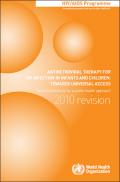Guidelines - Released in 2010
Significant obstacles remain to scaling up paediatric care, including limited screening for HIV, a lack of affordable, simple diagnostic testing technologies for children less than 18 months of age, a lack of human resources with the capacity to provide the care that is required, insufficient advocacy and understanding that ART is efficacious in children, limited experience with simplified, standardized treatment guidelines, and limited availability of affordable and practical paediatric ARV formulations. Health-care systems remain unable to meet the demands of national paediatric ART coverage. Consequently, far too few children have been started on ART in resource-limited settings. Moreover, the need to treat an increasing number of HIV-infected children highlights the primary importance of preventing transmission of the virus from mother to child in the first place.
The WHO guidelines Antiretroviral therapy for HIV infection in infants and children are based on a public health approach to HIV care. Updated in 2010, these guidelines are harmonized with the treatment guidelines adopted for adults, pregnant women, and for prevention of mother- to- child transmission (PMTCT).
The present guidelines are part of WHO’s commitment to achieve universal access to the prevention, care and treatment of HIV infection in infants and children.
Downloads
Organizations
- World Health Organization (WHO)






